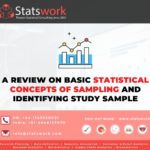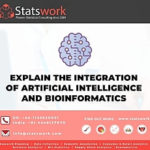Statistical contributions to bioinformatics: Design, modelling and integration.
In recent times, there has been a lot of research undertaken in the field of biological science. Biomedical researches are often considered to be an experimental design involving more number of genomic samples. The analysis of these types of structured big data poses a challenging task in the quantitative statistical analysis. To deal with those challenges, bioinformatics area has emerged to process the data efficiently with the help of statistical and biological scientists. In addition, statisticians are the key player in any designed experiment as they have the deeper knowledge of the outcome and uncertainty in the data processing. In this blog, I will point out some of the statistical contributions in designing, modelling and integrating the data in the field of bioinformatics.
Quick innovative advances joined by a precarious decrease in exploratory expenses have prompted a multiplication of genomic information across numerous logical controls and for all intents and purposes all infection regions.These incorporate high innovations that can profile genomes, metabolisms, etc at an exhaustive and point by point goal. This leads to various formats of data with varying sizes resulting in the increasing analytical and computational complexity. Thus, a data scientist or statistical data analysis services, Quantitative Data Analysis Services, Quantitative Statistical Analysis provided by an organisation plays a vital role in the bioinformatics field as it allows them to take decision on the sampling design, sampling plan and analysing the data to draw valid conclusions. The most common statistical approaches are algorithmic, stepwise procedures, etc since the data is not often complete in the sense that not all information are collected for the study due to the experimental cost. Let us look into the main part of the blog topic, that is, the highlights of the statistical principles in the field of bioinformatics.
Now, let us understand the importance of exploratory data analysis or descriptive statistical data analysis plan from an illustration noted in a paper by Petricoin et al. (2002). The example is about detecting the ovarian cancer based on the protemics test. The biologists developed a blood test called OvaCheck to detect the early symptoms’ of this cancer. Later, with the collected data, there arises few questions in their discoveries about the accuracy of the sampling design, sample size, and the conclusions made of out this. If one can use the same data to classify the patients with cancer or not, it may give different results and it has been discussed in detail by Morris andBaladandayuthapani (2017). Thus, it shows the need for exploratory data analysis before you decide anything about the population.
Next, we will understand why understanding the reproducibility of the study is statistically important especially when comes to prediction in bioinformatics studies. Potti et al. (2006) proposed a predictive strategy to identify the cancer types in patients using microarrays. It became very popular in the clinical and drugs’ marketing industry but later this methodology is not much useful to as this study involves many errors in the data processing stage.Further, the entire study is carried out one more time with the involvement of statistical experts to nullify the errors associated with the previous results. Thus, when we perform highly expensive clinical trials with large data, it is recommended to consult the statistical analysis and consulting services, or market research and competitive statistical analysis experts, to correctly do the data pre-processing and analysis and statisticians or people who can do professional help with analysis of statistical data, will take care of the errors and try to minimize the same in the beginning of the study. In addition to this, multiple testing is the major problem in the biological studies. Clinical scientist often ignores this error and use the traditional testing procedure to draw conclusions. A statistical experts will understand the multiple testing problem and understand the within group variability in the data and analyse the data according to get a valid inference.Furthermore, the above example explains the importance of the proper model used for the prediction purpose. The accuracy of the model can be identified using a cross-validation technique. Statisticians use the cross validation technique to identify how best the fitted model by splitting the dataset into training and testing data.
Sampling design is the major part of any clinical experiments. A good research involves a proper sampling plan and appropriate sample size to represent the population. With the help of statistical experts or any data analysis services, the clinical researcher can identify the suitable sampling design for the experiment and a valid and suitable sample size. Once the samples are collected, pre-processing the data is the most important and difficult task for any high dimensional datasets. The common method of pre-processing the data is the use of normalization and this is all purely rely on the statistical concepts where which only statisticians can do. In addition, modelling the genomic data or the clinical trials data involves many complex issues namely the data may involve missing observations, day is often longitudinal in nature, misreported entries in the data, etc. These types of issues need careful monitoring while performing any statistical analysis. Modelling such longitudinal data is often a tedious task as it involves the effects of the within group and between group variances. These specifications are not understandable and rectified by the clinical or biological scientist itself. Thus, with the help of statistical experts one can monitor all these issues and reduce the error in the model and improves the accuracy and reproducibility.
To sum up, statisticians or SPSS statistics help and data analysis servicesor Professional Statistics and statistical analysis services plays a prominent role in the field of bioinformatics starting from framing a research design, selecting the samples, till analysing and concluding the results out of it. Since biological or clinical experiments leads the researchers in getting vast amount of data and thus it provides opportunities for the statistical scientists to get involved in such experiments in a more deeper manner and pushing the field of science and technology a way forward and motivate the younger generations to discover many such findings. With this note, the major thing to keep in mind for conducting any bioinformatics experiments, I would say that there exists many challenges in the data pre-processing steps or the data cleaning step and it should be carefully handled by involving more statistical experts or statistical data analysis services for the appropriate results from the study.
References
- Hofner B, Schmid M, Edler L. Reproducible research in statistics: A review and guidelines for the biometrical journal. Biometrical Journal. 2016; 58(2):416–427.
- Jennings EM, Morris JS, Manyam GC, Carroll RJ, Baladandayuthapani V. Bayesian models for flexible integrative analysis of multi-platform genomic data. 2016
- Meyer M, Coull B, Versace F, Cinciripini P, Morris J. Bayesian function-on-function regression for multi-level functional data. Biometrics. 2016; 71(3):563–574.
- Morris JS, Baladandayuthapani V. Statistical Contributions to Bioinformatics: Design, Modeling, Structure Learning, and Integration. Stat Modelling. 2017;17(4-5):245-289. doi:10.1177/1471082X17698255
- Houwing-Duistermaat, JJ, Uh, HW and Gusnanto, A (2017) Discussion on the paper ‘Statistical contributions to bioinformatics: Design, modelling, structure learning and integration’ by Jeffrey S. Morris and VeerabhadranBaladandayuthapani. Statistical Modelling, 17 (4-5). pp. 319-326.



 Previous Post
Previous Post Next Post
Next Post